Legnica
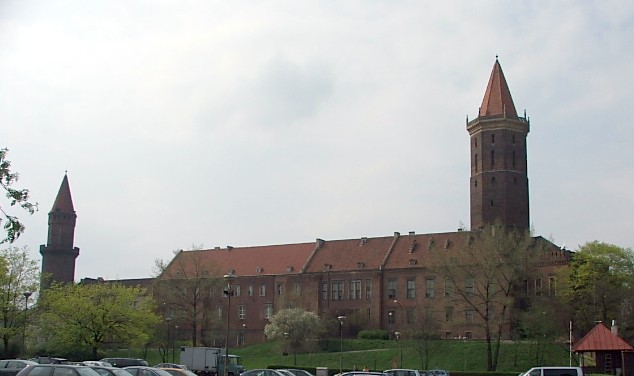
The castle of Legnica
Distance
Population
104.500 (2009)
Location and history
Legnica is the capital of the northwestern part of Lower Silesia, a city of both historical and contemporary significance. The city is located immediately north of the E40 motorway from the German border to Wrocław, Katowice and Kraków and at the motorway no. 3 from the Czech border via Jelenia Góra, which continues further north via Zielona Góra, iewiebodzin and Gorzów Wielkopolski to Szczecin.
For a period between the 7th and 11th years. was found in the place where the castle of Legnica now lies, a fortified area, surrounded by a fortification of wood and earth.
The name Legnica first appeared in the sources in 1149. – A document from 1175 confirms that Legnica was the seat of a mayor. The fortified area also included a front yard; 25-30 settlements were found within the timber and earth violence.
Legnica gets marketplace rights in 1264. However, the city's archives contain documents that mention earlier marketplace rights, namely granted in 1252, as well as the rights of 1264 and some later of 1280. The Dominican monastery in the city is founded by Prince Bolesław in 1278.
During the 13th and 14th centuries. the first walls are built around the city. In 1318, Bolesław III gave permission for the construction of a town hall. Legnica is expected to contain approx. 10,000 inhabitants. In 1329, Bolesław III, prince of Legnica-Brzeg, must officially recognize the supremacy of the Czech crown. In 1338, a great fire erupted, destroying large parts of the city. In 1353, Legnica obtained the right to freely choose a city council.
The city's fortifications were expanded in late 1420’s. Legnica had an extensive production of beer early; It is estimated that around 1430 there were no less than 30 breweries in the city.
In the first half of the 16th century, the town lord was Prince Fryderyk II of Legnica, who expanded the castle in the Renaissance style and began to develop Legnica into a fortress town.
In the second half of the 16th year. a process was begun to end up replacing the entire wood-built building stock with foundation-walled buildings.
During a plague epidemic in the 1630s, between 1300 and 2600 inhabitants perished in Legnica. – It is noted in the sources that from 1633 a functioning mailbox was hung on the Chojnów tower, apparently the first mailbox in the world.
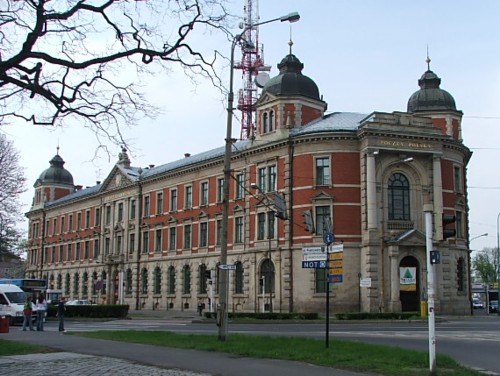
Post Office building in Legnica
In 1676, the city recognized the Habsburg emperor, Leopold I, as his lord lord. – After a previous imperial decree, in 1709 began the construction of the Knights Academy in Legnica. The knight academies were elite schools for the nobility's youth in preparation for a career in the army or at the court. Construction was completed in 1735.
During the Seven Years' War, Legnica was besieged by Prussian forces and had to surrender in 1757. – After 1808, Legnica was still under Prussia, but now the city had an autonomy followed by new Prussian legislation on the cities of the kingdom. – In 1835, the castle of Legnica burned with all its baroque interior.
The castle is being rebuilt in neo-Gothic style in 1838. -The City Theater was built in 1841-42. – From 1844 there is a rail link between Legnica and Wrocław. – In 1872 a monument depicting a sleeping lion was unveiled in memory of the citizens of Legnica who perished in the wars against Denmark (1864), Austria (1866) and France (1870). – In 1881 the Knight Academy was changed to high school. – Late 1880’The works worked as many as 7 piano buildings within Legnica’s urban area. – The post office at ul.Piastowska was built in 1890-92. – The new town hall in Legnica was built in 1902-05. – A new rebuilding of the castle took place in 1903.
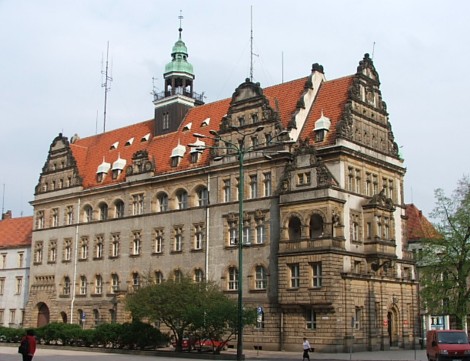
The town hall (the new town hall) in Legnica
At the beginning of World War I, in 1914, the number of Legnica residents was estimated at 69,561.
During the war, in 1915, ration marks for bread and flour were introduced. – Part of the municipal cemetery was separated for use as a war cemetery.
In 1917, the water level of the river Kaczawa, which runs through Legnica, rose by more than 5 meters above normal water level, causing flooding in large parts of the city.
In 1932, Adof Hitler visited Legnica, where he held a meeting that attracted approx. 40,000 people. – Construction of a highway between Legnica and Wrocław began in 1934. – Sub “crystal night”, on November 9-10, 1938, the Jewish synagogue in Legnica was burned.
The Second World War of 1939-1945 led to the militarization of large parts of the industry and the deterioration of living conditions for the population; ration labels for food and similar labels for industrial products were introduced. In 1942 the last Jews of Legnica were transported away.
On February 9, 1945, divisions of the Soviet army invaded Legnica. On April 6, parts of the Polish Army's 2nd Army march through the city. On April 25, 1945, a Polish operation group arrives to take over the civilian power of the Soviet army.
It is estimated that 1085 Poles and 24,000 Germans live in the city at that time.
On May 25, the Polish administration will take over the municipal buildings of the Soviet army.
In May-June 1945, the first repatriated Poles arrive at Legnica. Already in October, the population of the city had grown to 30,000.
In 1947, the Poles took control of the water supply and sewers.
The majority of German citizens still remaining in the city left Legnica in the period 1956-58.
In 1968 the trams were abandoned as a means of communication in the city and switched to driving exclusively by city buses.
In 1993, on September 16, the last wards of the Soviet army left Legnica.
As a result of the 1999 municipal reform, Legnica lost its status as a county town and instead became a district town.
From April 1999, the airport at Legnica is registered in the list of Polish civil airports.
During the period when the area and the city were under Germany, the city's name was Liegnitz.
Tourist attractions
Selected attractions:
Głogów Tower (Wieża Bramy Głogowskiej)
This former gate tower, which stands near the castle, is a brick tower with a square floor plan, built for defense purposes in the 15th century. In its time, the tower was to defend the Głogów Gate, which was nearby. On the southern facade a sundial is preserved.
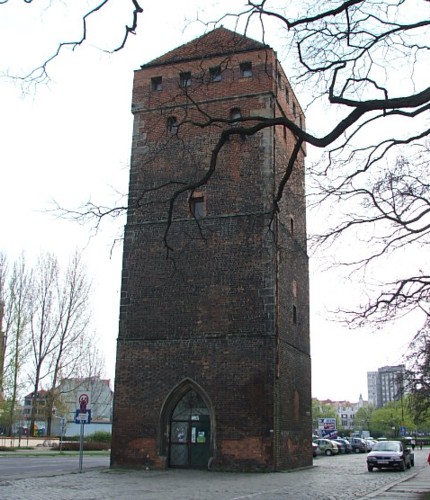
Głogów Tower
Chojnów Tower (Wieża Bramy Chojnowskiej)
This defense tower, in its time, had the task of guarding one of the city gates, the Chojnów Gate. The tower floor plan measures 7.4 × 8 m. Preserved are some of the original window openings and sliding doors. Near the tower is a remnant of the original city wall.
city Theater (Theater Miejski)
The theater traditions in Legnica date back to the 16th century. Construction of the current theater building began in 1840 and the house was inaugurated in December 1842. The Neo-Renaissance theater building is located on the central part of the square.
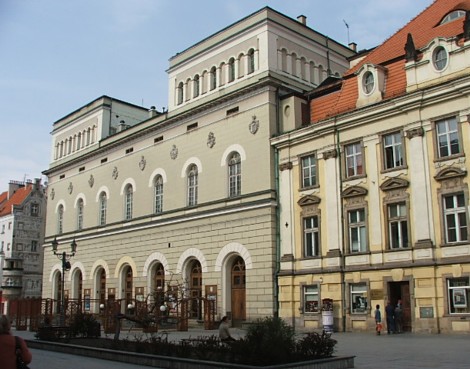
The City Theater of Legnica
Church of the Virgin Mary (Kosciół Marii Panny)
The Evangelical Virgin Mary Church is one of the oldest church buildings in Legnica. Around 1170, the Silesian prince Bolesław Wysoki built near the castle a smaller one-ship church, probably of wood; this building was replaced in 1892 by a stone walled church. The new church was in Romanesque style and was located in the northwest of the present building. The church was destroyed by fires in the 1300s, 1400s and most recently in 1822, but each time rebuilt. After the fire in 1822, the church was rebuilt in neo-Gothic style. Two similar towers were built and church vessels were added, which turned the building into a slave church. A later rebuild took place in 1903-1908.
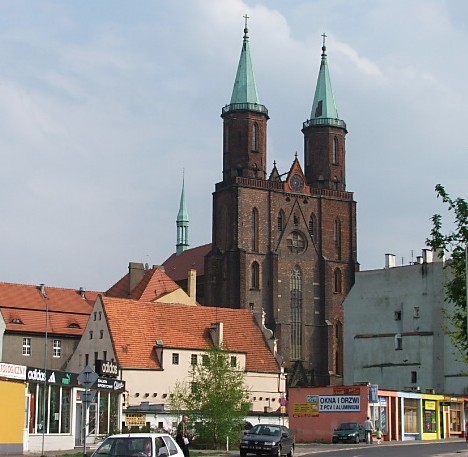
Church of the Virgin Mary
Borgen (Zamek Piastowski)
The castle in Legnica was built in brick at the transition between the 12th and 13th centuries. by Prince Henryk Brodaty. It was built where a fort was previously found, belonging to the West Slavic tribe of Trzebowianie. The building complex included a palatium, ie. a residential building, two towers and a defense wall partly of earth and wood, partly of brick. At that time, the complex was one of the strongest, ground-walled fortifications in Polish territory. The castle withstood the Mongol attack in 1241. In the following centuries, the castle was expanded and modernized and developed into a presentable residence for the princes of Legnica-Brzeg (of the Piast genus). After extensions in the 16th and 17th centuries. the castle was changed to a four-wing complex. In the east wing, the entrance gate was preserved in Renaissance style. After the death of Prince Georg Wilhelm, the last prince of the Piast lineage, the castle came into the hands of the German emperors. In 1764, King Friedrich II ordered the castle fortress to be demolished and in 1796 the moat was filled. After a fire in 1835, the castle was rebuilt, so that the prevailing building style was now neo-Gothic. In February 1945, upon the capture of the Red Army by the city, the castle was burnt down and destroyed. The reconstruction took place in 1962-1969, and the complex was designed for teaching purposes. It should be noted that the following building elements which have retained their original shape:
The Renaissance-style entrance portal. – Parts of the Late Romanesque chapel in the courtyard. – The two towers: St. Jadwiga Tower and St. Piotr Tower.
- See photo above.
Peter and Paul Cathedral (Cathedral pw św. Św. Apostołów Piotra i Pawła)
The church was first mentioned in the documents in 1208. In its present form, the church was built in 1333-1380. In 1341 the new church was consecrated by the bishop of Wrocław. In the 15th year. There was an extensive expansion, which surrounded the church building with 9 chapels, associated fraternities, guilds or rich families. In 1892-94 the church was rebuilt in neo-Gothic style. Following an administrative reform within the Catholic Church in Poland, the church in 1892 gained the status of a cathedral in Legnica.
The church is rich in valuable equipment and interesting details. Note, among other things: the Gothic stone sculptures at the entrance gates, the bronze baptismal font with a sculptural composition, 5 statues of apostle stones, the tombstone with sculptures by Prince couple Ludwik II and his wife Elżbieta of Brandenburg, the Renaissance pulpit in stone from 1586 -88, baroque organ, baroque altar by Legnica sculptor Krystian Grunewald, completed in 1769.
“herring houses” (Kamieniczki “śledziowe”)
These houses are first mentioned in 1574. Their name probably derives from the fishing stalls at whose place they were erected. It is a complex of eight three-storey houses, located on the central part of the square. Some are equipped with Renaissance style gables, others with classicist gables. A few of the houses are decorated with old decorations that were uncovered in 1930’s.
Knight Academy (Akademia Rycerska)
The city's most prominent Baroque building forms a large block between four streets (including Chojnowska and Św.Jana) in the northwest of the old city. The academy was built over a number of decades by drawings by Krystian Hertel. In 1728, the construction of the four-wing complex began. First the east, south, and west wings were built, and later the northern wing followed. The studies at the Academy lasted 3 years. The Knight Academy was a school for the noble youth; students should be at least 16 years old. Geography, history, law, philosophy, mathematics, but also equestrian and martial arts were studied. Several well-known people have received teaching here, including Stanisław Lubomirski, the late crown's great marshal, and Andrzej Zamoyski, who later became the crown's chancellor. The institution was closed down in 1811; instead, the Johanneum high school emerged. After World War II, the complex was taken over by the Red Army, which administered it until 1978. During that time, the academy was largely run down and destroyed. Although it has been taken over by the Polish authorities many years ago, the complex is still undergoing renovations.
The new town hall
See photo above.
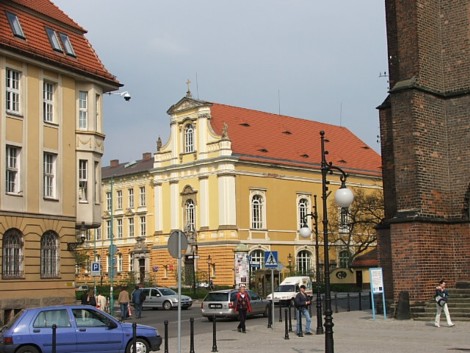
From Plac Mariacki in Legnica. The Church of the Virgin Mary is on the right
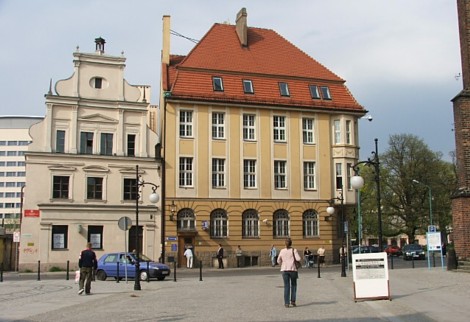
From Plac Mariacki in Legnica
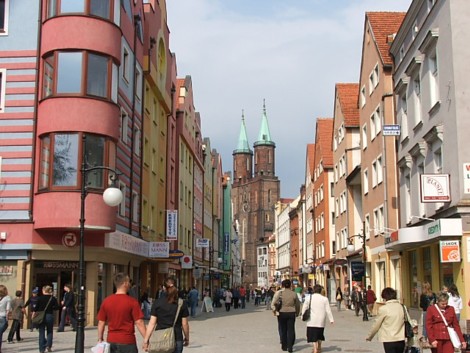
Church of the Virgin Mary seen from the south
Surrounding Area
Accommodation
Booking.com
Legnica. Oficjalny portal miasta
Eating Out:
Legnica. Oficjalny portal miasta
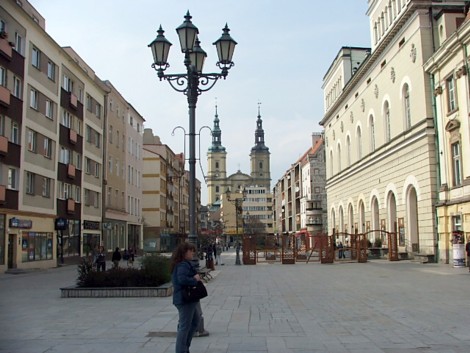
Square. In the background is the Church of John the Baptist (Kościół św. Jana Chrzciciela)
Other Internet sites and sources
Legnica. Oficjalny portal miasta
Translated into English by Google Translate. Spangshus.dk accept no liability for any errors or omissions in translation.
Map

Rating
Search
Most used tags
churches (205) Castles (86) Monasteries (79) Town walls (74) Lakes (71) Town halls (67) Rivers (65) Castles1 (62) Mansions (55) Museums (51) Regional museums (38) Town gates (36) Abbey churches (35) Castle ruins (30) Cathedrals (26) Forests (25) Health resorts (24) Mounds (23) Water sports (23) National parks (22)Click for all tags
Denne side er også tilgængelig på dansk. This page and contents is (c) Copyright 2018- www.spangshus.dk. Based on Inviator software by ISCA Software